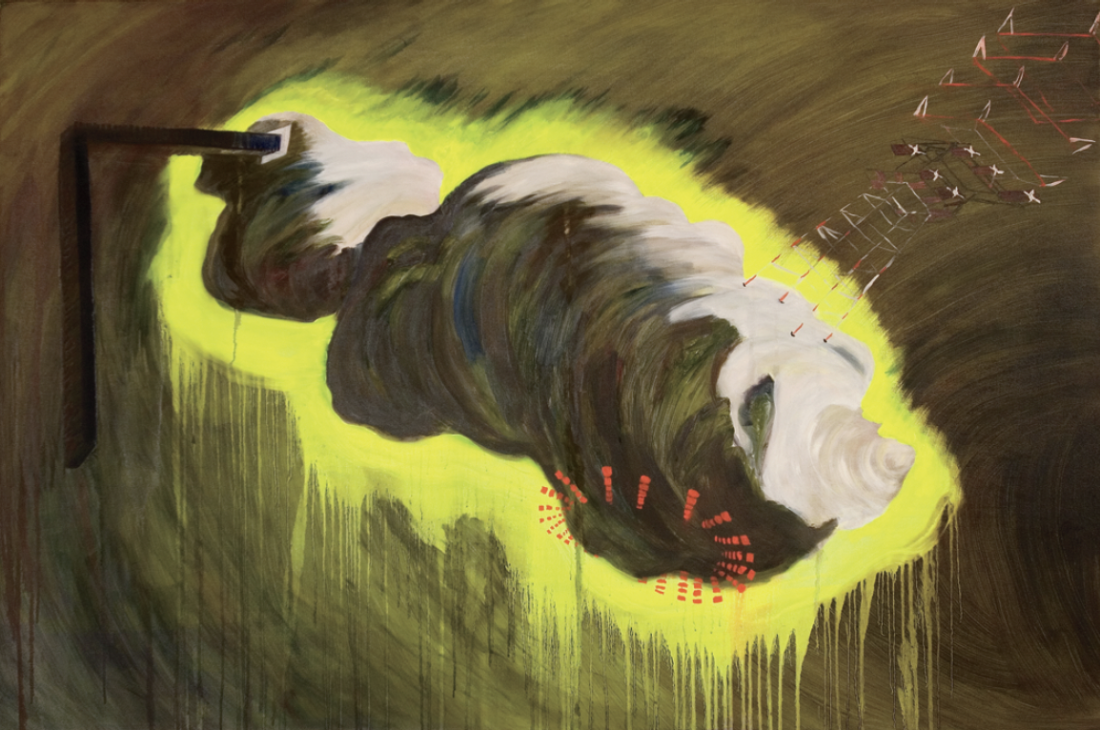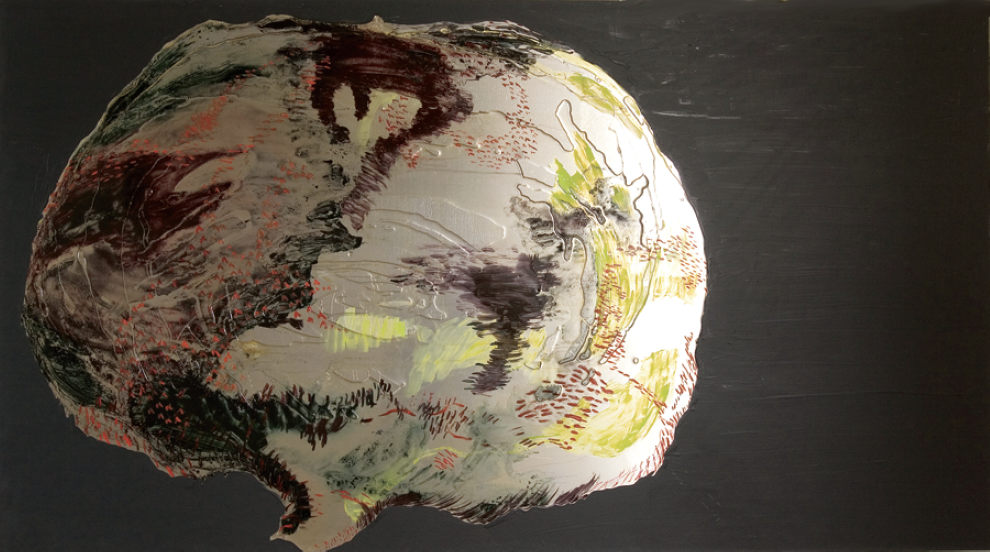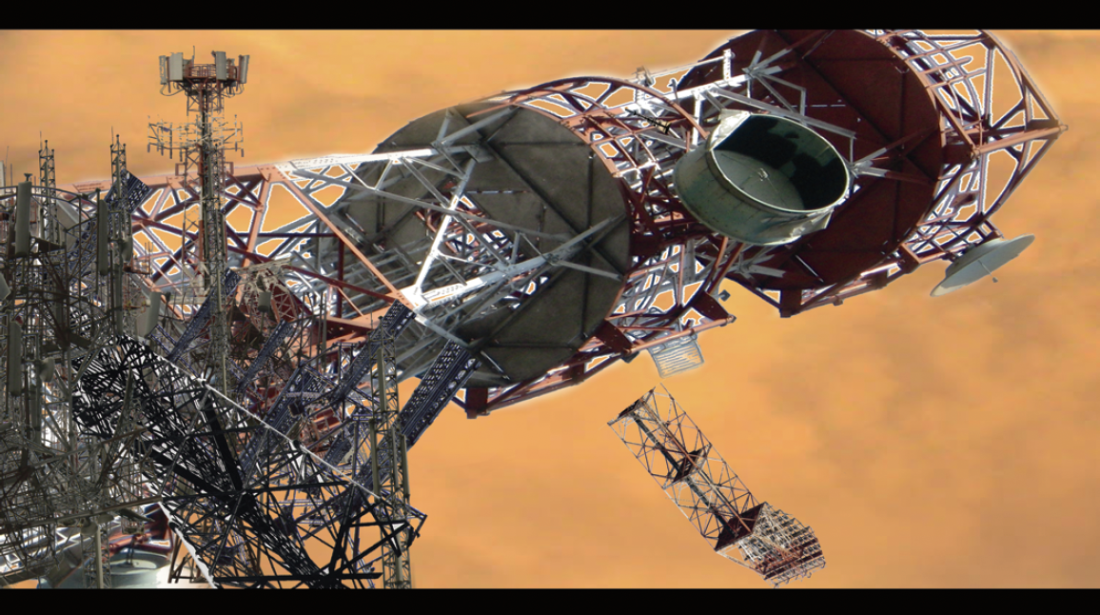Kevin Kelly
As cell phones have become an indispensible accessory for contemporary living, communication towers have become innocuous entities in our outdoor surroundings—non-descript, cage-like structures that reach high into the sky, bouncing waves off satellites, ensuring we are staying in touch, up to date and connected. Given India’s population of 1.3 billion people, it has one of the largest markets for cell phones in the world. In the first quarter of 2008 Winnipeg/Montréal artist Kevin Kelly travelled back to India to do a one month residency in Bangalore. He had not been there for over 30 years and was taken aback by the proliferation of communication towers that now littered the country’s landscape. Before his trip to India, Kelly had begun a study of asteroid formations and was particularly fascinated by Oort— a cloud of comets and asteroids that exists hypothetically beyond Pluto. Finding images of asteroids on NASA ’s website, Kelly began to translate their shapes and forms in oil paint onto aluminium plates, or with mixed media on vellum or paper. He successfully married the asteroid imagery with the architecture of the communication tower, conflating the two and creating a series of fantastical and prophetic associations.

Kevin Kelly, Ida, 2007, oil on aluminium, 36 x 66”. Photo by Sheila Spence.
The result of this research and exploration culminated in the exhibition “Colonizing Oort,” in which the gallery space is transformed. Works of various sizes inhabit the entire room—suspended off the walls, hovering at different heights, some positioned at the ceiling edge, others located close to the floor, like a field of asteroids of sorts—that slowly and effortlessly float about in a weightless, meditative state yet are tenuously held together in cluster formations by some illusive magnetized pull. Seeming to defy gravity are 12 aluminium plates that depict otherworldly forms. Lush in the application of paint, the low-tech art of painting is coupled to the high-tech formation of machined aluminium. Kelly creates unsettling portraits of astral bodies and the works take their names from the actual subjects. Vesta, one of the largest known asteroids, is noted for its diverse landforms, and in Kelly’s painting, it mimics the shape of an atomic explosion, or a comic comment bubble. Its illuminated form depicts an earth-like landscape, as seen from outer space, complete with terra firma, watery bodies, vapour clouds and migratory red gases that layer one on top of the other. Perhaps Kelly’s asteroids are leftovers from an ancient advanced civilization that has blown itself to bits. Some of the asteroid portraits are augmented with satellite towers, such as Ida, 2007, representing the compulsive colonization of technology over the landscape, both earthbound and in outer space. The final frontier is no longer unclaimed; as with the moon or arctic poles, it is staked out, but instead of flags or church towers, the colonizers employ satellites that constantly orbit and occasionally collide with one another, creating great clouds of high-tech debris—a contemporary form of garbage-cum-comet cluster.

Kevin Kelly, Vesta, 2007, oil, enamel and resin on aluminium, 36 x 66”. Photo by Sheila Spence.
In addition to the paintings is Air Sell, a three-minute Flash animation. Kelly’s digital photos of the numerous communication towers he encountered during his travels in India is set to a collage of found sounds that he apparently had gathered from India’s eclectic soundscape. Here, the unmistakable irritating sound of a cell phone ringing, Fred Flintstone screaming “yabba dabba do,” the theme song from Friends, bleeps from video games, Bollywood sound tracks and children’s schoolyard rhythms become the backdrop to a surreal landscape that begins as an empty, curved edge of a planet and is quickly overcome by a plague of towers that rain from the sky. The towers dance, float about, and then collectively rocket into space quivering and jerking, possessed with a primal rutting energy, then flying off into a cloudy, ethereal, orangey-pink sunset.

Kevin Kelly, Bangalore Rupture Clusterfuck (still), 2009, digital print, 24 x 49”.
An extension of this exhibition is Bangalore Rupture Clusterfuck, a series of 16 glossy vinyl prints derived from video stills taken from the Air Sell. Displayed in the University of Winnipeg’s Buffeteria, the images of communication towers descending or blasting off into the glow of a heavily polluted skyscape mimics the behaviour of the students in this environment who are scattered about in clusters, chattering, connecting, and then breaking apart, all this activity likely filtered by some form of technology.
A wonderful complement to the entire project is the limited edition artist’s book published by As We Try & Sleep Press. Almost like a mini-exhibition in a box, the book includes an insightful text by JJ Kegan McFadden printed on the back of an image of the works in the exhibition, an accordion book of NASA asteroid images, a piece of raw silk hand printed with images of communication towers and a digital photo of Kelly’s travels in India. On the photo’s reverse is a travelogue excerpt by the artist: “India is absolutely beyond all expectation. I will get used to this. If I am lucky I will not get used to this.”❚
“Colonizing Oort” was exhibited at Gallery 1C03 at the University of Winnipeg from January 22 to February 21, 2009.
Mary Reid is the Curator of Contemporary Art and Photography at the Winnipeg Art Gallery.

